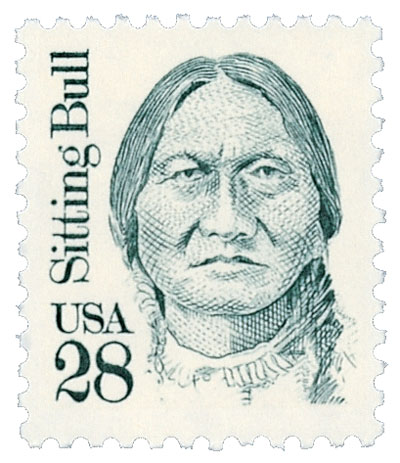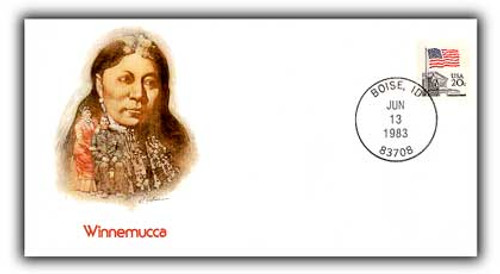
# 121048 - PAI Sitting Bull 1983
Â
Â
Death Of Lakota Leader Sitting BullÂ
The Hunkpapa Lakota leader known as Sitting Bull was born in 1831 near the Grand River in present-day South Dakota. At birth he was named Jumping Badger, but also received the nickname Slow, because he didn’t rush through anything. After showing great courage in a battle against the Crow Indians at age 14, he was given the name “Buffalo Bull Who Sits Down,†which was later shortened to “Sitting Bull.â€
Sitting Bull had little contact with whites until the Santee Sioux uprising in 1862. When U.S. Army soldiers attacked his village during the Civil War, Sitting Bull led the defense. He also led an attack on a deserted military wagon party. Though he was shot in that altercation, his wounds weren’t serious.
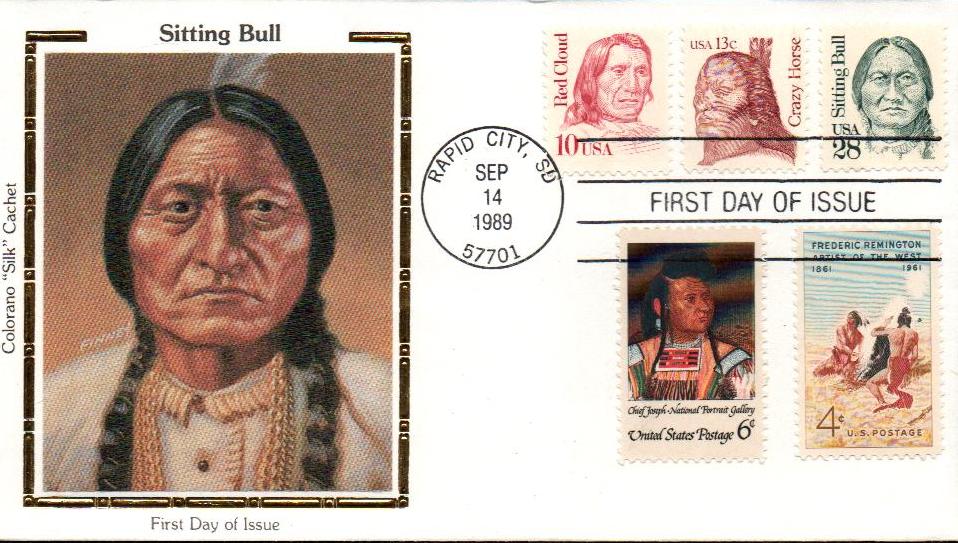
In the coming years, Sitting Bull joined in Red Cloud’s War. Red Cloud sought to maintain control of the Powder River Country in Montana. During this time, Sitting Bull led attacks on several forts including Berthold, Stevenson, and Buford. In 1868, the U.S. government agreed to Red Cloud’s demands that they leave Forts Phil Kearny and C.F. Smith. Several other Native American leaders signed the Treaty of Fort Laramie, but Sitting Bull refused, stating, “I wish all to know that I do not propose to sell any part of part of my country.â€
For several years, Sitting Bull continued to attack American forts and migrating parties. In the early 1870s, surveyors for the Northern Pacific Railroad came to the area to explore a possible route through Hunkpapa lands. Sitting Bull and his followers put up a stiff resistance and forced the surveyors to flee. The surveyors continued to return to the area in the coming years, with increased military support, but were turned away each time. The panic of 1873 then bankrupted most of the railroad’s backers, halting their efforts.
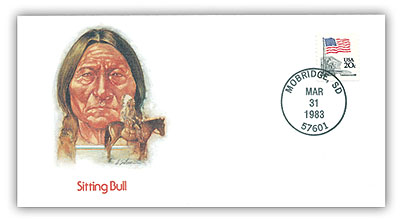
Also in the 1870s there was great interest to open the Black Hills for gold mining and settlement. Though the Treaty of Fort Laramie had promised to protect the Sioux and their land, the government sought a way around this. So in 1875, President Ulysses S. Grant ordered that all Sioux in the area move onto the Great Sioux Reservation. An order by the Interior Department then certified all bands living off the reservation as hostile, and gave the military permission to pursue them.
During this time, Sitting Bull emerged as a major leader in his tribe. While many other bands had followed the government’s orders to move to the reservation, many didn’t, and took refuge at Sitting Bull’s camp. He even sent his men out to the reservations to recruit warriors. By June 1876, Sitting Bull’s camp had more than 10,000 people in it.
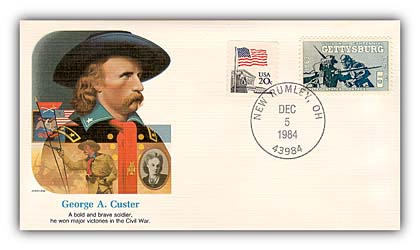
Then on June 25, 1876, American Lieutenant Colonel George Armstrong Custer discovered the camp, though he underestimated the number of people there. He then launched an attack at the camp, along the Little Big Horn River. Though Sitting Bull didn’t fight, he’d previously had a vision of U.S. soldiers being killed as they entered the camp. His followers trusted his vision and fought back. Custer’s men were overwhelmed and retreated, but the tribes then launched a counter-attack and wiped out the attacking American force.
Sitting Bull’s follower’s believed his vision had brought them victory and celebrated. However, the American public was shocked and outraged over Custer’s death and the government’s knowledge of the Sioux living outside the reservation. So the government then flooded the area with thousands more soldiers. But Sitting Bull refused to surrender. In May 1877, he led his followers into Canada, where he remained in exile for four years. He was even offered a pardon and a chance to return, but refused.
While in Canada, Sitting Bull befriended the mounted police as well as Crowfoot, the leader of the Blackfeet, a long-time enemy of his tribe. However, his presence in Canada increased tensions between that nation and the U.S. Additionally, there were fewer buffalo to hunt, so his people were starving. Eventually Sitting Bull was desperate for his people, so he and 186 of his followers returned to America and surrendered on July 19, 1881. He proclaimed, “I, Takanka Iyotanka, wish it to be remembered that I was the last man of my tribe to surrender my rifle.â€
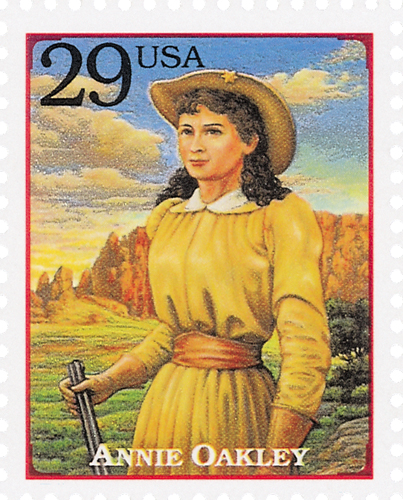
Sitting Bull and his followers then spent 20 months at Fort Randall as prisoners of war, before returning north to live on the Standing Rock Reservation. In 1884, Sitting Bull was invited to tour Canada and the northern U.S. in a show called the “Sitting Bull Connection.†During this tour, he met and befriended Annie Oakley. He was impressed with her shooting ability and symbolically adopted her as his daughter. He called her “Little Sure Shot,†a name she used throughout her career.
The following year, Sitting Bull was again invited to travel, this time as part of Buffalo Bill’s Wild West show. He received $50 a week to ride around the arena. He also gave speeches urging education for children and improving relations between the Sioux and whites.
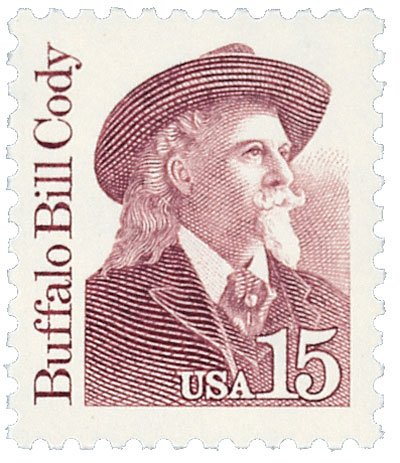
In the late 1880s and early 1890s, the Ghost Dance Movement took root. The movement sought a return to tradition and called on tribes to dance and chant for their deceased relatives to rise up and bring back the buffalo. While Sitting Bull didn’t appear to participate in the movement, he allowed the dancers to come to his camp. The Indian Agents at Standing Rock Reservation believed he was going to leave the reservation with the dancers and ordered his arrest.
The arrest was planned for 5:30 a.m. on December 15, 1890. That morning, 39 police officers and four volunteers surrounded and entered Sitting Bull’s house. They told him he was under arrest and had to mount a horse to meet with the Indian Affairs agent. Sitting Bull refused and the officers used force. This enraged his followers, leading to an all-out fight in which Sitting Bull was shot twice. He died that afternoon. Three years later, his cabin on the Grand River was moved to Chicago to be placed on exhibit at the 1893 World’s Columbian Exposition.
Â
Â
Death Of Lakota Leader Sitting BullÂ
The Hunkpapa Lakota leader known as Sitting Bull was born in 1831 near the Grand River in present-day South Dakota. At birth he was named Jumping Badger, but also received the nickname Slow, because he didn’t rush through anything. After showing great courage in a battle against the Crow Indians at age 14, he was given the name “Buffalo Bull Who Sits Down,†which was later shortened to “Sitting Bull.â€
Sitting Bull had little contact with whites until the Santee Sioux uprising in 1862. When U.S. Army soldiers attacked his village during the Civil War, Sitting Bull led the defense. He also led an attack on a deserted military wagon party. Though he was shot in that altercation, his wounds weren’t serious.

In the coming years, Sitting Bull joined in Red Cloud’s War. Red Cloud sought to maintain control of the Powder River Country in Montana. During this time, Sitting Bull led attacks on several forts including Berthold, Stevenson, and Buford. In 1868, the U.S. government agreed to Red Cloud’s demands that they leave Forts Phil Kearny and C.F. Smith. Several other Native American leaders signed the Treaty of Fort Laramie, but Sitting Bull refused, stating, “I wish all to know that I do not propose to sell any part of part of my country.â€
For several years, Sitting Bull continued to attack American forts and migrating parties. In the early 1870s, surveyors for the Northern Pacific Railroad came to the area to explore a possible route through Hunkpapa lands. Sitting Bull and his followers put up a stiff resistance and forced the surveyors to flee. The surveyors continued to return to the area in the coming years, with increased military support, but were turned away each time. The panic of 1873 then bankrupted most of the railroad’s backers, halting their efforts.

Also in the 1870s there was great interest to open the Black Hills for gold mining and settlement. Though the Treaty of Fort Laramie had promised to protect the Sioux and their land, the government sought a way around this. So in 1875, President Ulysses S. Grant ordered that all Sioux in the area move onto the Great Sioux Reservation. An order by the Interior Department then certified all bands living off the reservation as hostile, and gave the military permission to pursue them.
During this time, Sitting Bull emerged as a major leader in his tribe. While many other bands had followed the government’s orders to move to the reservation, many didn’t, and took refuge at Sitting Bull’s camp. He even sent his men out to the reservations to recruit warriors. By June 1876, Sitting Bull’s camp had more than 10,000 people in it.

Then on June 25, 1876, American Lieutenant Colonel George Armstrong Custer discovered the camp, though he underestimated the number of people there. He then launched an attack at the camp, along the Little Big Horn River. Though Sitting Bull didn’t fight, he’d previously had a vision of U.S. soldiers being killed as they entered the camp. His followers trusted his vision and fought back. Custer’s men were overwhelmed and retreated, but the tribes then launched a counter-attack and wiped out the attacking American force.
Sitting Bull’s follower’s believed his vision had brought them victory and celebrated. However, the American public was shocked and outraged over Custer’s death and the government’s knowledge of the Sioux living outside the reservation. So the government then flooded the area with thousands more soldiers. But Sitting Bull refused to surrender. In May 1877, he led his followers into Canada, where he remained in exile for four years. He was even offered a pardon and a chance to return, but refused.
While in Canada, Sitting Bull befriended the mounted police as well as Crowfoot, the leader of the Blackfeet, a long-time enemy of his tribe. However, his presence in Canada increased tensions between that nation and the U.S. Additionally, there were fewer buffalo to hunt, so his people were starving. Eventually Sitting Bull was desperate for his people, so he and 186 of his followers returned to America and surrendered on July 19, 1881. He proclaimed, “I, Takanka Iyotanka, wish it to be remembered that I was the last man of my tribe to surrender my rifle.â€

Sitting Bull and his followers then spent 20 months at Fort Randall as prisoners of war, before returning north to live on the Standing Rock Reservation. In 1884, Sitting Bull was invited to tour Canada and the northern U.S. in a show called the “Sitting Bull Connection.†During this tour, he met and befriended Annie Oakley. He was impressed with her shooting ability and symbolically adopted her as his daughter. He called her “Little Sure Shot,†a name she used throughout her career.
The following year, Sitting Bull was again invited to travel, this time as part of Buffalo Bill’s Wild West show. He received $50 a week to ride around the arena. He also gave speeches urging education for children and improving relations between the Sioux and whites.

In the late 1880s and early 1890s, the Ghost Dance Movement took root. The movement sought a return to tradition and called on tribes to dance and chant for their deceased relatives to rise up and bring back the buffalo. While Sitting Bull didn’t appear to participate in the movement, he allowed the dancers to come to his camp. The Indian Agents at Standing Rock Reservation believed he was going to leave the reservation with the dancers and ordered his arrest.
The arrest was planned for 5:30 a.m. on December 15, 1890. That morning, 39 police officers and four volunteers surrounded and entered Sitting Bull’s house. They told him he was under arrest and had to mount a horse to meet with the Indian Affairs agent. Sitting Bull refused and the officers used force. This enraged his followers, leading to an all-out fight in which Sitting Bull was shot twice. He died that afternoon. Three years later, his cabin on the Grand River was moved to Chicago to be placed on exhibit at the 1893 World’s Columbian Exposition.




